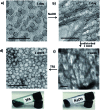An addressable packing parameter approach for reversibly tuning the assembly of oligo(aniline)-based supra-amphiphiles
- PMID: 29896380
- PMCID: PMC5956978
- DOI: 10.1039/c8sc00068a
An addressable packing parameter approach for reversibly tuning the assembly of oligo(aniline)-based supra-amphiphiles
Abstract
We present a newly developed approach to non-covalently address the packing parameter of an electroactive amphiphile. The pH-responsive reversible switching of a tetra(aniline)-based cationic amphiphile, TANI-pentyl trimethylammonium bromide (TANI-PTAB), between self-assembled vesicles and nanowires by acid/base chemistry in aqueous solution is used to exemplify this approach. Trifluoroacetic acid (TFA) was selected as a prototypical acid to form emeraldine salt (ES) state (TANI(TFA)2-PTAB) vesicles for this new class of small-molecule supramolecular amphiphiles. UV-vis-NIR spectroscopy, transmission electron microscopy (TEM), tapping-mode atomic force microscopy (AFM), and fluorescence spectroscopy were used to investigate the reversible structural transformation from vesicles to nanowires. We show that utilising different protonic acid-dopants for TANI-PTAB can regulate the packing parameter, and thus the final self-assembled structures, in a predictable fashion. We envisage potential application of this concept as smart and switchable delivery systems.
Figures








Similar articles
-
Tunable Self-Assembled Nanostructures of Electroactive PEGylated Tetra(Aniline) Based ABA Triblock Structures in Aqueous Medium.Front Chem. 2019 Jul 25;7:518. doi: 10.3389/fchem.2019.00518. eCollection 2019. Front Chem. 2019. PMID: 31403042 Free PMC article.
-
Self-Assembly of a Functional Oligo(Aniline)-Based Amphiphile into Helical Conductive Nanowires.J Am Chem Soc. 2015 Nov 18;137(45):14288-94. doi: 10.1021/jacs.5b06892. Epub 2015 Nov 5. J Am Chem Soc. 2015. PMID: 26496508 Free PMC article.
-
From bola-amphiphiles to supra-amphiphiles: the transformation from two-dimensional nanosheets into one-dimensional nanofibers with tunable-packing fashion of n-type chromophores.Chemistry. 2012 Jul 9;18(28):8622-8. doi: 10.1002/chem.201200898. Epub 2012 Jun 20. Chemistry. 2012. PMID: 22718555
-
Molecular Recognition Driven Bioinspired Directional Supramolecular Assembly of Amphiphilic (Macro)molecules and Proteins.Acc Chem Res. 2021 Jun 1;54(11):2670-2682. doi: 10.1021/acs.accounts.1c00195. Epub 2021 May 20. Acc Chem Res. 2021. PMID: 34014638 Review.
-
Self-Assembly of Photoresponsive Molecular Amphiphiles in Aqueous Media.Angew Chem Int Ed Engl. 2021 May 17;60(21):11604-11627. doi: 10.1002/anie.202007693. Epub 2021 Feb 24. Angew Chem Int Ed Engl. 2021. PMID: 32936521 Free PMC article. Review.
Cited by
-
A unique amphiphilic triblock copolymer, nontoxic to human blood and potential supramolecular drug delivery system for dexamethasone.Sci Rep. 2021 Nov 2;11(1):21507. doi: 10.1038/s41598-021-00871-w. Sci Rep. 2021. PMID: 34728694 Free PMC article.
-
Controllable and Diversiform Topological Morphologies of Self-Assembling Supra-Amphiphiles with Aggregation-Induced Emission Characteristics for Mimicking Light-Harvesting Antenna.Adv Sci (Weinh). 2020 Sep 23;7(20):2001909. doi: 10.1002/advs.202001909. eCollection 2020 Oct. Adv Sci (Weinh). 2020. PMID: 33101876 Free PMC article.
-
Electroactive Amphiphiles for Addressable Supramolecular Nanostructures.ChemNanoMat. 2018 Aug;4(8):741-752. doi: 10.1002/cnma.201800194. Epub 2018 Jul 4. ChemNanoMat. 2018. PMID: 31032175 Free PMC article. Review.
-
Tunable Self-Assembled Nanostructures of Electroactive PEGylated Tetra(Aniline) Based ABA Triblock Structures in Aqueous Medium.Front Chem. 2019 Jul 25;7:518. doi: 10.3389/fchem.2019.00518. eCollection 2019. Front Chem. 2019. PMID: 31403042 Free PMC article.
References
-
- Faul C. F. J. Acc. Chem. Res. 2014;47(12):3428–3438. - PubMed
-
- Kim H. J., Kim T., Lee M. Acc. Chem. Res. 2011;44(1):72–82. - PubMed
-
- Dichiarante V., Milani R., Metrangolo P. Green Chem. 2018;20:13–27.
-
- Eastoe J., Gold S., Rogers S., Wyatt P., Steytler D. C., Gurgel A., Heenan R. K., Fan X., Beckman E. J., Enick R. M. Angew. Chem., Int. Ed. 2006;45(22):3675–3677. - PubMed
LinkOut - more resources
Full Text Sources
Other Literature Sources
Miscellaneous

